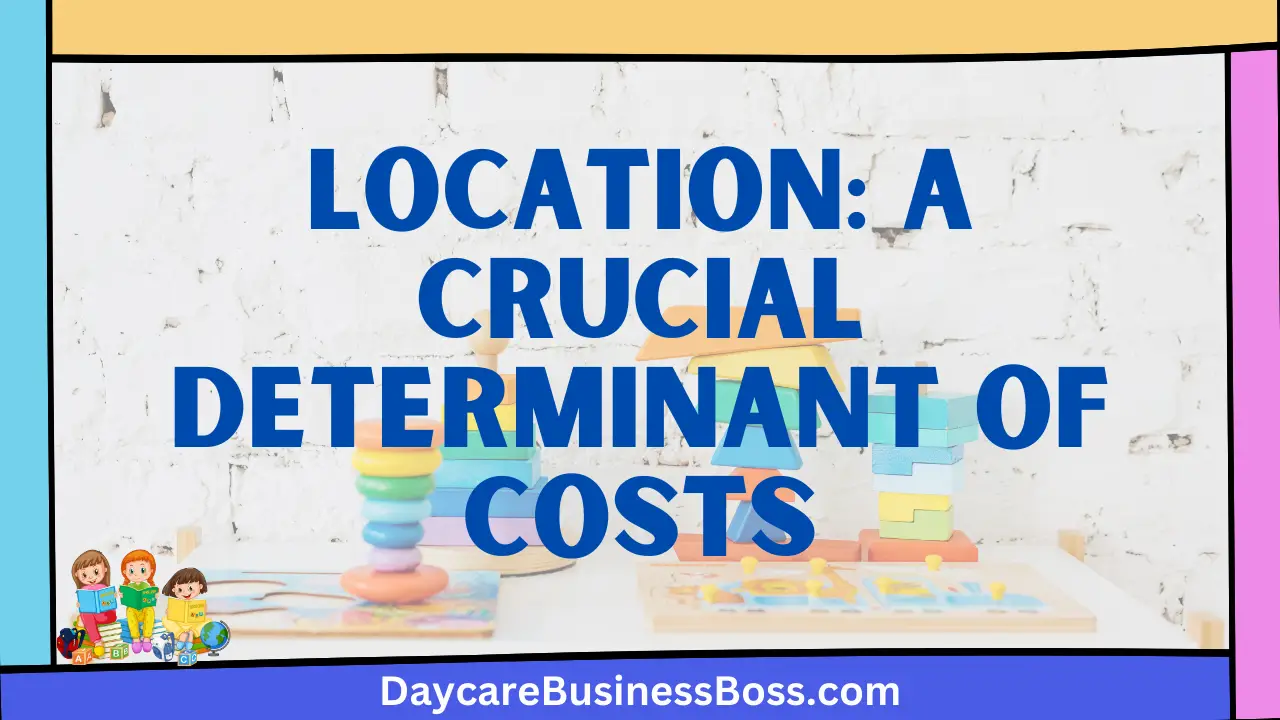The decision to enroll your child in daycare is an important one that is influenced by a variety of variables. Among these, the financial component can be critical in deciding the viability and affordability of such a decision. At-home daycare has grown in popularity as an alternative to typical childcare institutions, providing specialized care in the comfort of one’s own home. However, given the unpredictability impacted by various factors, evaluating the potential expenses connected with at-home daycare can be difficult.
The best way to estimate potential at-home daycare costs is to consider factors such as location, services provided, and the number of children enrolled. In the U.S., the average weekly rate for at-home daycare ranges from $140 to $300 per child. For precise and reliable cost estimates, it’s recommended to research local rates in your area.
Location: A Crucial Determinant of Costs

The geographical location in which the services are sought has a considerable impact on the cost of in-home daycare services. Daycare expenses are subject to spatial variations in the same way that real estate prices and the overall cost of living vary across different regions. This issue is crucial in defining the financial considerations of parents or guardians looking for childcare for their children.
In comparison to their rural or suburban counterparts, urban areas, with their bustling streets and high population densities, may have higher at-home childcare expenses. This dramatic disparity in pricing can be due to a variety of variables. For starters, increased demand for childcare services in metropolitan areas drives up overall expenses. As more working parents or guardians seek dependable childcare, the demand for daycare spaces increases, allowing providers to charge greater prices.
The operational costs associated with at-home daycare companies in urban areas are intrinsically higher. Overhead expenditures in urban areas are higher, encompassing everything from rent and utilities to employee pay and equipment maintenance. These increased operational costs unavoidably transfer into higher daycare fees to ensure the business’s long-term viability.
Daycare alternatives are more diverse in metropolitan areas, catering to a wider range of interests and needs. However, the variety of options comes at a high cost. The ease of use and accessibility of specialized services, such as bilingual or Montessori-based education, contribute to the premium pricing.
Rural areas, on the other hand, with their tranquil scenery and sparse inhabitants, tend to provide more economically viable at-home childcare options. Although there are fewer possibilities, the lower cost of living in some areas leads to more reasonable daycare rates. Due to lesser overhead, daycare providers’ operational expenses are generally lower, and these cost savings are frequently passed on to the parents or guardians seeking these services.
Read more about: Tiny Steps to Big Investments: Financial Insights into Starting a Daycare Business
Services Provided: Tailoring Costs to Your Needs
The range of services offered by in-home daycare providers is critical in creating the financial landscape of childcare prices. This multiple issue complicates the economic factors that parents or guardians must negotiate when looking for appropriate care for their children.
The scope of services provided by at-home childcare providers varies greatly. Some providers offer comprehensive packages that include a wide range of services, from basic caregiving responsibilities to a multitude of enjoyable activities. These all-inclusive programs could include everything from dinner preparation to educational participation, and even transportation. These comprehensive solutions might be a useful answer for busy families by combining multiple necessities into a single cost.
However, the variety does not stop there. The services offered by in-home childcare providers can be adjusted to different age groups. Infant care, which requires particular attention and care, frequently charges higher prices due to the increased demands it makes on the caregiver. The need for frequent feedings, diaper changes, and continual supervision for infants needs more caregiver participation, which has a knock-on effect on the whole cost structure.
Aside from the age-based distinctions, the provision of supplemental amenities raises the prospective price even further. Daycare providers who provide structured learning programs that include activities aimed to promote early childhood development and education may charge different prices. Similarly, provisions for field trips or outings that broaden a child’s exposure to the world outside the family environment add to the overall cost. The promise of one-on-one attention, assuring tailored care and learning, can also influence the eventual cost.
When parents or guardians begin the process of evaluating childcare costs, they must carefully consider the specific services that fit with their child’s needs and personal preferences. This entails a thorough assessment of the offerings and their related worth in light of the family’s particular circumstances.
Number of Children Enrolled: Shared Costs and Individual Attention
The number of children enrolled in an at-home daycare setting plays a dual function in generating the complex terrain of childcare expenses, with its influence visible through a sophisticated interaction of factors. This numerical variable provides a duality in which size and scale coexist, ultimately guiding the financial considerations that parents or guardians traverse while weighing daycare options.
The notion of economies of scale comes into play in bigger group settings with a larger number of youngsters enrolled. The sharing of expenditures across a bigger cohort can result in a lower per-child cost, perhaps resulting in a more financially realistic alternative for parents. This cost-sharing approach holds the possibility of providing high-quality daycare while not putting a significant financial load on individual families.
A smaller group size, on the other hand, provides a contrasting value proposition. Individualized attention and care emerge as a significant advantage in these intimate situations. Caregivers can focus on the individual needs and preferences of each child with fewer children to attend to, creating a customized experience that resonates with parents who value personalized care.
Recognizing these opposing dynamics, providers frequently set their rates depending on the delicate balance of group size and caregiver-child ratio. To ensure the safety, well-being, and optimal development of every child entrusted to their care, the correct balance must be struck. This balance is a pillar of respectable in-home daycare facilities, ensuring parents that the number of caregivers is adequate to ensure the highest standards of supervision and participation.
When assessing childcare costs, parents or guardians must contend with the conflict between group size and quality of care. The benefits of bigger group settings, such as lower costs, must be balanced against any trade-offs in personalized attention. Alternatively, while smaller group numbers promise individualized treatment, the corresponding premium cost may present financial issues.
Average Weekly Rates: A National Overview

The national average rates emerge as an extra guiding beacon in the complex landscape of predicting at-home childcare expenses, where variables such as location, services offered, and group size exert significant influence. While this indicator does not provide an entire blueprint, it does serve as a key touchstone that tempers expectations and provides insight into the larger financial landscape of at-home daycare.
In the United States, a country known for its regional diversity and volatile economic fluctuations, the average weekly rate for in-home daycare takes center stage. This amount, which ranges from about $140 to $300 per child per week, reflects the multidimensional nature of daycare costs. The breadth of this range includes the previously described components, demonstrating how the interaction of geographical location, services provided, and group size combine to determine the final cost.
While this national average is informative, it should be viewed as a fundamental starting point rather than a fixed figure. It serves as a resource for parents and guardians to assess the financial viability of their childcare goals. However, it is critical to understand that in-home daycare expenses are intrinsically flexible to individual situations, allowing for a level of flexibility that reflects the individuality of each family’s situation.
The range of factors behind at-home daycare costs assures that the national average is merely a compass, providing direction rather than dictation. Parents or guardians must be prepared for potential variations that may develop as a result of the complex dance of variables within their situation. The specifics of their chosen location, the degree of services they choose, and the group size they choose all influence the final price they pay.
Read more about: Average childcare teacher salary
Researching Local Rates: Precise and Reliable Estimates
The art of extensive research into local rates is a vital compass in the quest for precise and dependable estimates of at-home daycare costs. This exploratory voyage entails diving into multiple channels of information, each providing a unique perspective point that, when combined, paints a full picture of the financial environment that awaits parents or guardians looking for childcare alternatives.
For information searchers, the digital environment has emerged as a valuable hunting area. Online resources, ranging from parenting blogs to local community forums, include a wealth of information gained from the firsthand experiences of parents in the same geographic area. These digital narratives provide an authentic look at the real-world expenditures that parents bear for in-home daycare services. Community forums, in particular, encourage open discussions, allowing parents to openly share their financial experiences and provide practical advice to other carers.
When it comes to predicting at-home daycare expenditures, word of mouth, a time-honored means of knowledge transfer, is worth its weight in gold. Conversations with friends, neighbors, and colleagues who have used childcare solutions before might provide useful information. These human experiences, which include both achievements and setbacks, provide an organic perspective that adds richness to the understanding of local childcare financial environments.
Digital sites that aggregate daycare provider information develop as comparative analysis beacons. These websites not only provide a curated list of local at-home childcare providers, but they also provide baseline rates for these services. This gives parents a starting point for comparing different providers, kicking off a careful review process.
However, direct connection typically yields the most interesting findings. Contacting potential daycare providers, whether through email, phone calls, or in-person visits, can shed light on the complexities that influence their services and accompanying pricing. Scheduling visits to these companies not only provide a firsthand look at their layout but also allows for an open discussion about financial considerations.
Among this array of research resources, it’s critical to remember that, while the national average provides a starting point, the primary compass directing at-home daycare prices is the local environment. Geographical peculiarities, cultural dynamics, and economic volatility all come together to determine the specific financial scenario that parents or guardians face.
Frequently Asked Questions

What variables influence the price of in-home daycare?
The cost of in-home childcare can vary depending on several factors, the most important of which is location. Because of increasing demand and operational requirements, urban regions often have higher costs. The services offered also play a role; full packages that include educational programs and luxuries may result in higher costs. The number of children enrolled and the caregiver-to-child ratio might have an impact on expenditures. All of these factors contribute to the wide range of at-home daycare prices.
How can I accurately estimate prospective at-home daycare costs?
To accurately estimate at-home childcare costs, consider the location, services provided, and the number of children enrolled. Begin by investigating the cost of living in your location and local daycare charges. Determine whether your child requires specific services and whether you prefer a larger group environment or more individualized attention. Contact possible daycare providers to learn more about their services and fees. By combining this information, you may generate a more exact estimate that is personalized to your situation.
Why is it vital to investigate local rates when evaluating at-home daycare costs?
It is critical to research local rates because it offers you exact and dependable cost estimates. While the national average for in-home childcare expenses is useful as a starting point, it may not accurately reflect the cost situation in your area. Local rates consider the regional cost of living, the demand for childcare services, and other factors that are specific to the area. This research enables you to make informed decisions by providing you with a realistic picture of the potential costs involved with at-home childcare for your child.
To learn more on how to start your own daycare checkout my startup documents here.
The information provided by DaycareBusinessBoss.com (“The Site”) is for general informational purposes only. All information on the Site is provided in good faith, however, we make no representation or warranty of any kind, express or implied, regarding the accuracy, adequacy, validity, reliability, availability or completeness of any information on the Site. Under no circumstance shall we have any liability to you for any loss or damage of any kind incurred as a result of the use of the Site or Reliance on any information provided on the Site. Your use of the Site and your reliance on any information on the Site is solely at your own risk.
This blog post is for educational purposes only and does not constitute legal advice. Please consult a legal expert to address your specific needs. Terms and Conditions. (https://daycarebusinessboss.com/terms-conditions/)

Meet Shawn Chun: Entrepreneur and Childcare Business Fan.
I’m a happy individual who happens to be an entrepreneur. I have owned several types of businesses in my life from a coffee shop to an import and export business to an online review business plus a few more and now I create online daycare business resources for those interested in starting new ventures. It’s demanding work but I love it. I do it for those passionate about their business and their goals. That’s why when I meet a childcare business owner, I see myself. I know how hard the struggle is to retain clients, find good employees and keep the business growing all while trying to stay competitive.
That’s why I created Daycare Business Boss: I want to help childcare business owners like you build a thriving business that brings you endless joy and supports your ideal lifestyle.


